- Home
- Technical Cooperation Projects
- Index of Countries
- Middle East
- Egypt
- The Project for the Conservation Center in the Grand Egyptian Museum
- Project News
- Succeeding the Ancient Egyptian Textile Artifacts to the Next Generations in Good Condition –Textile Conservation Training Course II–
Project News
2013-04-23
Succeeding the Ancient Egyptian Textile Artifacts to the Next Generations in Good Condition –Textile Conservation Training Course II–
The JICA Grand Egyptian Museum-Conservation Center (GEM-CC) Project has already conducted two "Training Courses on Textile Conservation". The first session (Textile Conservation I) was done from 14th to 17th of October, 2012. And then the second session (Textile Conservation II) was carried out on 12th of March and from 14th to 23rd of April, 2013 at the venue of the GEM-CC.
The "Textile Conservation І", as the preparatory stage, focused on understanding basic knowledge on documentation of textile artifacts (structure, materials and deterioration) and characteristics of the making techniques, and it also aimed the trainees to experience the necessary practices, which enable to plan and conduct the fundamental research studies including the scientific examination and analysis by themselves.
The "Textile Conservation ІІ" has been launched as a fully-fledged training program on textile conservation in the Project. In the first half of the session (12th of March, 2013), the trainees learnt about the chemistry of dye, the dyeing techniques and conservation science of the textile artifacts through the lectures. The first part of this course was instructed by Prof. Yasunori MATSUDA, the technical chief adviser of the JICA GEM-CC Project, who specialized in conservation science.
As for the second half of the "Textile Conservation ІІ" training carried out from 14th to 23rd of April, 2013, 16 conservators and 4 scientists of the GEM-CC participated in this training course. It focused on documentation of the artifacts, the dyeing techniques and the general principles and the procedures in textile conservation, such as the cleaning, interventional treatment and preservation based on the understanding of conservation ethics and the scientific reasons. The course also aimed to build up their communication skills, which are necessary for being the conservation professionals. The follow-up training of the "Textile Conservation I" was also conducted. This session was instructed by Dr. Mie ISHII, textile conservator and visiting researcher of the National Research Institute for Cultural Properties, Tokyo (NRICPT) and Ms. Midori YOKOYAMA, part-time instructor of NHK Culture Center, who specialized in embroidery and textile conservation.
The instructors focused on not only lecturing about necessary knowledge for textile conservation, but also providing the opportunity of the practical training to develop the capacities of trainees. They instructed in the preparation methods for the application of the interventional cleaning techniques such as the solubility tests for the textiles, the dyes and so on, as well as in the cleaning methodology, such as the mechanical, chemical and enzyme cleaning. They also taught the techniques of the bleaching with the proper agents and humidification for the flattening of the wrinkled textiles.
In this course, the enzyme cleaning was the most difficult training program for trainees. Before the application of the enzyme cleaning, trainees were first required to understand the fundamental background knowledge of the enzyme chemistry. In addition to that, in the practice, the enzymes have to be applied for removing the stains from the deteriorated textile samples with the appropriate amount of the enzymes in the suitable conditions. The trainees also need to understand how to evaluate the performance of the enzymes and how to remove residual enzyme after the cleaning or removing stains on the textile. Those knowledge and experience absolutely required for practicing the enzyme clearing cannot be mastered in a short period of time. Therefore, trainees were so eager to utilize this amazing opportunity to a maximum extent to learn and absorb those knowledge and techniques of the enzyme clearing through this training course.
It was only a second time to implement the textile conservation training course. So, the JICA GEM-CC Project is planning more training opportunities of textile conservation to be held both in Japan and Egypt for the GEM-CC conservators and scientists. Now there is great expectation among the involved participants that the GEM-CC staffs will be taking advantage of the learnt and absorbed techniques, knowledge and experience through those training courses, for conservation of the fragile and deteriorated textile collections discovered in the tomb of Tutankhamen for their future exhibition in the GEM.
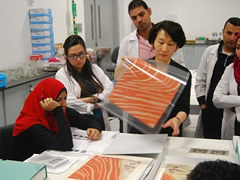 Dr. Ishii explaining preservation of textile objects with the transparent plastic sheet
Dr. Ishii explaining preservation of textile objects with the transparent plastic sheet
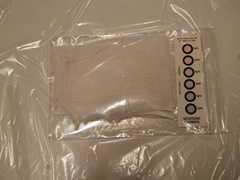 Experimental practice on monitoring microclimate of the textile objects with the humidity indicator
Experimental practice on monitoring microclimate of the textile objects with the humidity indicator
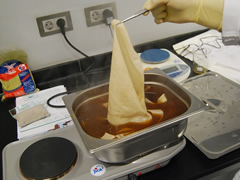 Dyeing textiles samples with natural dye
Dyeing textiles samples with natural dye
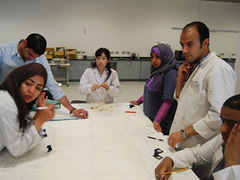 GEM-CC trainees practicing magnified observation to document textile artifacts (middle: Ms. Yokoyama)
GEM-CC trainees practicing magnified observation to document textile artifacts (middle: Ms. Yokoyama)
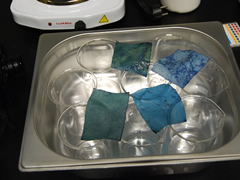 Dyed textile samples with indigo
Dyed textile samples with indigo
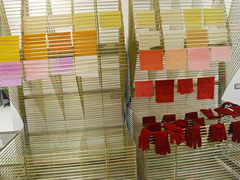 Dyed colorful textile samples (Red = Saffron, Yellow = Turmeric, Pink = Safflower, Orange = Henna)
Dyed colorful textile samples (Red = Saffron, Yellow = Turmeric, Pink = Safflower, Orange = Henna)
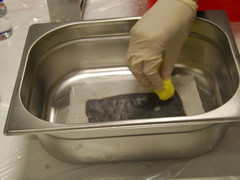 Clearing of textile samples with application of chemical agents
Clearing of textile samples with application of chemical agents
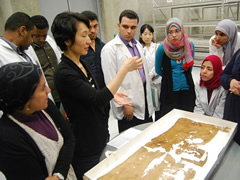 At the GEM-CC storage, Dr. Ishii explaining collection management for the textile artifacts
At the GEM-CC storage, Dr. Ishii explaining collection management for the textile artifacts
- About JICA
- News & Features
- Countries & Regions
- Our Work
- Thematic Issues
- Types of Assistance
- Partnerships with Other Development Partners
- Climate Change / Environmental and Social Considerations
- Evaluations
- Compliance and Anti-corruption
- Science and Technology Cooperation on Global Issues
- Research
- JICA Development Studies Program / JICA Chair
- Support for the Acceptance of Foreign HRs / Multicultural and Inclusive Community
- Publications
- Investor Relations
